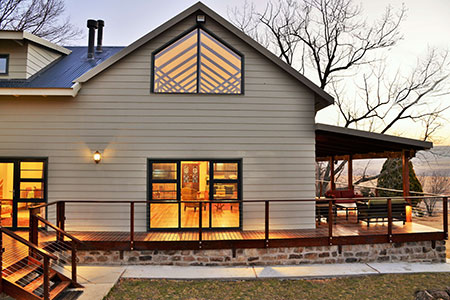House for all seasons
Situated on a cattle farm just outside Memel in the Free State, this home is a retirement dream brought to life with timber frame construction. With difficult building terrain underpinned by heavy clay conditions, a timber structure was as much a practical choice as it was an aesthetic one.
27/01/2018
Having bought the land a number of years prior, the client sought to have a structure built on the farm that was dedicated to both leisure time in the country and entertaining friends and family. This vision of function strongly informed the design brief, which came to pivot on a large double-volume cathedral-type space at the centre.
"The design of House Memel took shape from the inside out with the entertainment area a central aspect of the design motivation and as a result, its physical form," says Werner Slabbert Jnr, Managing Director of Eco Log Homes, who were contracted to the build. "The result is a spacious Vermont plank house with a large central hall from which bathrooms, open-plan kitchen, a bedroom, dining room, indoor and outdoor braai and entertainment areas, extend. A special highlight for us is the magnificent loft area which adds tremendous value to a structure that boldly reflects, both aesthetically and structurally, the values of Eco Log Homes," he adds.
Designing for the elements
The architecture of House Memel also took cues from the harsh weather conditions of the area, which can become very windy, cold and wet. "We thus turned to more northern architecture, particularly Alaskan design, to help inform key elements of the structure," says Slabbert, explaining, "In a bid to create the most comfortable indoor climate in otherwise unforgiving weather conditions, optimal orientation was essential; the house is positioned facing exact north, bedrooms are situated on the eastern side and the design allows for minimal fenestration and light entry on the western side to shield against the morning and afternoon sun. In addition, the wraparound veranda aids temperature control and the house features no fewer than three fire places for indoor heating when needed."
Timber frame building was the construction method of choice for the client, given the extreme clay conditions of the soil, which had already seen the existing brick and mortar farm house cracked to pieces.
"Timber as a building material is so flexible and adaptable, which makes it especially well suited to building on unforgiving terrain such as this," remarks Slabbert. "This building methodology is also the most efficient way to build a house with exceptionally robust insulating properties to withstand the elements and create a comfortable interior environment for its occupants.
These two requirements presented by the project alone made timber construction the most suitable building option for House Memel," he says.
Structural composition
CCA-treated (to H3) 38 mm x 114 mm S5 strength-graded structural South African Pine timber was used to build the walls and floors of the house in line with the National Building Regulations’ South African National Standard (SANS) 10082, which covers correct timber frame building in South Africa.
Wall cavities were packed with 102 mm cavity batt insulation, with internal walls finished with 15 mm fire-stop gypsum board prior to plastering. Exterior walls are finished with a waterproof membrane and 11 mm thick oriented strand board, adding to both the insulating value of the walls as well as the structural bracing and integrity of the house. Wood grain textured fibre cement planks complete the exterior cladding.

"House Memel represents a thoughtful response to a client brief for a timber frame home, with leisure and entertainment at heart, and with difficult soil conditions for construction," says Slabbert. "Timber was the ideal construction material with which to bring House Memel to life, due to both soil and weather conditions in the area.
Thanks to its strength and insulating properties, the occupants will be able to enjoy a comfortable, well-insulated structure that is built to last; well-considered design and high-quality finishes layer brawn with beauty for a sturdy, yet luxurious structure that will comfortably weather both the elements and shifts in design trends for years to come," Slabbert concludes.








